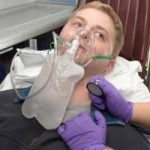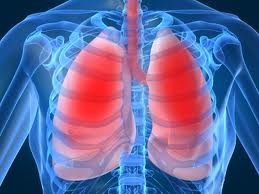Pulmonary fibrosis develops once the lung tissue happens to be scarred and damaged. It will be difficult for the lungs to work appropriately if its tissue is hard and thickened. There will be more increasingly shortness of breath as the pulmonary fibrosis gets worse. The scarring of the lung tissue which connected with the pulmonary fibrosis can be caused by a great number of factors. However, in most cases of pulmonary fibrosis, health care providers cannot identify the reason behind this illness. It is known as idiopathic pulmonary fibrosis once the cause cannot be identified.
Since lung damage caused by pulmonary fibrosis cannot be mended, there are available medications and treatments that can help to relieve the symptoms and make everyday life get better. Lung transplant may also consider for some people.
What are the signs and symptoms of pulmonary fibrosis?
Signs and symptoms of pulmonary fibrosis may include the following.
- Dyspnea or shortness of breath
- Dry cough
- Fatigue or weariness
- Inexplicable weight loss
- Painful joints and muscles
Â
The development of pulmonary fibrosis and its severity can differ significantly from person to another. Some people may turn out to be extremely ill rapidly with severe illness. Some may have moderate symptoms that get worse for over months or years.
What are the causes of pulmonary fibrosis?
The scarred and thickened tissue between and around the air sacs or called alveoli inside the lungs are what causing hard for the oxygen to pass in the bloodstream. Airborne toxins in the place of work and certain lung illnesses are the possible causes by this damaged.
Lasting exposure to a lot of pollutants and toxins can harm the lungs and these include the following.
- Silica powder
- Asbestos fiber
- Grain dust
- Animal and bird droppings
People who are given radiation therapy intended for breast or lung cancer may show signs of lung damage months or years after having the primary treatment. The intensity of the damage may differ on the following.
- How to the great extent of the lung was being exposed to radiation
- The total quantity of radiation being administered
- If the treatment was done with the combination of chemotherapy
- The existence of primary lung illness
There are a lot of medicines that can cause damage to the lungs, particularly:
- Chemotherapy drugs that used to destroy cancer cells like the cyclophosphamide and methotrexate that can also cause damage to the lung tissue.
- Hear medications that intended for irregular heartbeats like the amiodarone or propranolol that may also harm the lung tissue.
- Some of the antibiotics that can also harm the lung tissue are the sulfasalazine and the nitrofurantoin.
Damage of the lung tissue can also result from some diseases like:
- Pneumonia
- Tuberculosis
- Rheumatoid arthritis
- Systemic lupus erythematosus
- Sarcoidosis
- Scleroderma
The condition wherein the cause of pulmonary fibrosis is not known after conducting thorough health check is known as idiopathic pulmonary fibrosis. There are a lot of theories from research studies of the factors that may trigger idiopathic pulmonary fibrosis like the viruses and exposure to tobacco smoke. Genetics may also contribute to the possible development of idiopathic pulmonary fibrosis.
What is the risk factors affecting pulmonary fibrosis?
The factors that can make you more at risk of having pulmonary fibrosis are:
- People in middle ages and older adults have more increased risk of pulmonary fibrosis even though there are also children and infants being affected with pulmonary fibrosis.
- People who smoke and done smoking may have greater possibility to develop pulmonary fibrosis than to those people who never done smoking.
- People who are working in mining, farming or construction that are being exposed to pollutants have a greater possibility of having pulmonary fibrosis.
- People who received radiation treatments or had used chemotherapy drugs are more vulnerable to pulmonary fibrosis.
- You are at increased risk if it runs in your family.
What are the treatments for pulmonary fibrosis?
The existing treatment for pulmonary fibrosis cannot be reversed the scars in the lung tissue. Preventing the progression of the disease using the modern treatments are not even yet proven effective. However, some of these treatments can make the symptoms get better or slow the disease’s development that can really help to improve quality of life.
1.    Intake of medications.
 Corticosteroid is the medications used as a primary treatment. It is prescribed sometimes in combination with other medicines that used to suppress the immune system like the methotrexate or cyclosporine.
Corticosteroid is the medications used as a primary treatment. It is prescribed sometimes in combination with other medicines that used to suppress the immune system like the methotrexate or cyclosporine.
2.    Make use of oxygen therapy.
 Making use of oxygen will not stop the lung damage although it can make the breathing and exercise more easily, avoid or reduces the complications from low blood-oxygen levels, lessen the blood pressure in the right side of the heart, and make the sleep get better.
Making use of oxygen will not stop the lung damage although it can make the breathing and exercise more easily, avoid or reduces the complications from low blood-oxygen levels, lessen the blood pressure in the right side of the heart, and make the sleep get better.
3.    Undergo pulmonary rehabilitation.
 The objective of pulmonary rehabilitation is not only to have treatment to people affected with pulmonary fibrosis but also to help them make the everyday lives get better. Pulmonary rehabilitation programs concentrate on the physical exercise to make the endurance get better, breathing methods to progress the lung efficiency, emotional support and nutritional therapy.
The objective of pulmonary rehabilitation is not only to have treatment to people affected with pulmonary fibrosis but also to help them make the everyday lives get better. Pulmonary rehabilitation programs concentrate on the physical exercise to make the endurance get better, breathing methods to progress the lung efficiency, emotional support and nutritional therapy.
4.    Surgical procedure.
 This will be the last alternative if there is no improvement obtained from other treatment option. Lung transplantation may be recommended by the doctor for people with younger ages having severe pulmonary fibrosis.
This will be the last alternative if there is no improvement obtained from other treatment option. Lung transplantation may be recommended by the doctor for people with younger ages having severe pulmonary fibrosis.
Living with pulmonary fibrosis should be keenly involved with the own treatment and maintain to be in good physical shape as possible to still have a full enjoyable life.
